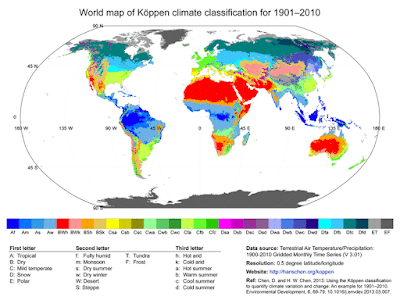By pure luck I was born on a farm in Africa. Specifically, South Africa, and more specifically in the heart of the Garden Route in the Southern Cape region of the Western Cape. This area is described as one of the most beautiful parts of South Africa and it's no exaggeration, although South Africa is blessed with many and diverse breathtaking areas.
Not exaggerating? OK, let's start on a global scale. On the Southern tip of Africa, surrounded with the Atlantic Ocean in the West and the Indian Ocean in the East, lies the country of South Africa. So what makes the geography of South Africa so unique and diverse? Firstly, it is divided into three distinct regions: (1) The Coastal Plains (2) the Great Escarpment and (3) the massive interior plateau.
One of the best ways to characterize a region’s climate is through the use of the Köppen Climate Classification which divides the world into regions as a function of their average temperatures, precipitation and seasonal patterns.
In the West cold and hot arid deserts are spanning over the land with the coastal areas being a mix of arid and temperate climates. The further East you move, the more intense the precipitation gets and the desert turns to Steppe and then a large temperate area. Looking over to the coast you find the tallest mountain range in South Africa before the coastal strip in the far East turns into a tropical savannah.
This climatic diversity spanning the entire country together with its climatic isolation being bound by a thick layer of equatorial and desert climates to the North also has created a very unique flora environment. Looking at the global distribution of plants the botanist Ronald Good identified six distinct natural separations of flowering plants which he calls “Floristic Kingdoms”.
Four of these, the Holarktis, Neotropis, Palaeotropis and Australis cover nearly the entire planet, but the flora that developed on the Southern tip of the African continent was determined to be too distinct to be grouped into any of these kingdoms, making it its own, Capensis, or Cape Floral Kingdom.
This relatively small area is not only very different from the rest of the world, but also extremely diverse within itself boasting thousands of different plants many of which is endemic to South Africa. To put some numbers on this, it is estimated that the roughly 200km coastal belt is home to around 9000 species of plants (mostly “Fynbos”), of which around 6000 can only be found here, on par with areas like the Malaysian Tropical Rain Forest or the Amazon. This diversity also constitutes one fifth of all plant species found across the African continent.
A single mountain like the Table Mountain outside Cape Town houses more different plant species than the entirety of the UK. These diverse ecosystems also led to the evolution of an extremely diverse fauna where South Africa joins the ranks of the so called mega-diverse countries in the world each of them boasting over 5000 endemic species. Hundreds of unique mammals, reptiles, amphibian and bird species are unique to South Africa.
The topography too is as diverse as can get. The Southwestern coastal plains are characterized by the Cape fold belt, a series of parallel running mountain ranges. From the steep cliffs of Table Mountain, the mountain ranges continue along the Southern African coastline until Mozambique where the relatively thin coastal plain rises continuously towards the inner continental shelf. The highest region of the great escarpment are the Drakensberg mountains in the Southeastern part of the country. With an elevation of over 3450m resulting in a high Alpine climate similar to the Alps in Europe. The high altitude even brings seasonal snowfall having allowed small ski resorts to operate on the highest peaks of South Africa and Lesotho. The Drakensberg escarpment is an incredible nature spectacle to explore, but the whole range spanning from Cape Town is riddled with spectacular passes. Just behind the towering escarpment the elevated land opens up to form the great African plateau which curves through the inner continent.
Despite being reasonably isolated and remote the area is so incredibly important to human history. It is thought to be the birthplace of Homo-Sapiens. We as humans could not have picked a more fascinating country to start our journey from. If pre-history is your thing, once again Southern Africa is the place to explore.
As a whole, South Africa is a fascinating country with so many geographical stories to tell. From its extremely diverse climate, fascinating mountain ranges and rivers there is something new to learn everywhere.
In most parts of our planet, you have to drive several hundred kilometers just to start seeing a change in your environment, but within a 50km radius from where I sit here typing this article, I can be on beautiful beaches, in lush forests, semi-arid Karoo, climbing mountains or exploring historic passes.
Like I said, by pure luck I was born here. How blessed can one be?
This blog was dormant for a while. There have been a few posts here and there since and more than one attempt to revive my passion for blogging. But here we go again. Come with as I explore our beautiful country.





No comments:
Post a Comment